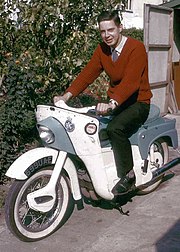Construction
The construction of modern motorcycles has mostly standardized on the key components listed below.
Chassis
The chassis (or frame) of a motorcycle is typically made from welded aluminium or steel (or alloy) struts, with the rear suspension being an integral component in the design. Carbon-fiber and titanium are used in a few very expensive custom frames.
The chassis includes the head tube that holds the front fork and allows it to pivot. Some motorcycles include the engine as a load-bearing (or stressed) member; this has been used all through bike history but is now becoming more common.
Oil-in-Frame (OIF) chassis, where the lubricating oil is stored in the frame of the motorcycle, was used for Vincent motorcycles of the fifties, and for a while during the 1970s on some NVT British motorcycles. It was widely unpopular and generally regarded as a bad idea at the time. Today it is a widely used idea on "thumpers" (single-cylinder four-strokes) that usually have a dry-sump lubrication requiring an external oil tank. It has since gained some cache in modern (2006) custom bike world too because of the space saving it can afford and the reference to an earlier era. Buell motorcycles employ a similar design - the oil is held in the swingarm, while the fuel is held in the frame.
Front fork
A motorcycle fork is the portion of a motorcycle that holds the front wheel and allows one to steer. For handling, the front fork is the most critical part of a motorcycle. The combination of rake and trail determines how stable the motorcycle is.
A fork generally consists of two fork tubes (sometimes also referred to as forks), which hold the front wheel axle, and a triple tree, which connects the fork tubes and the handlebars to the frame with a pivot that allows for steering.


No comments:
Post a Comment